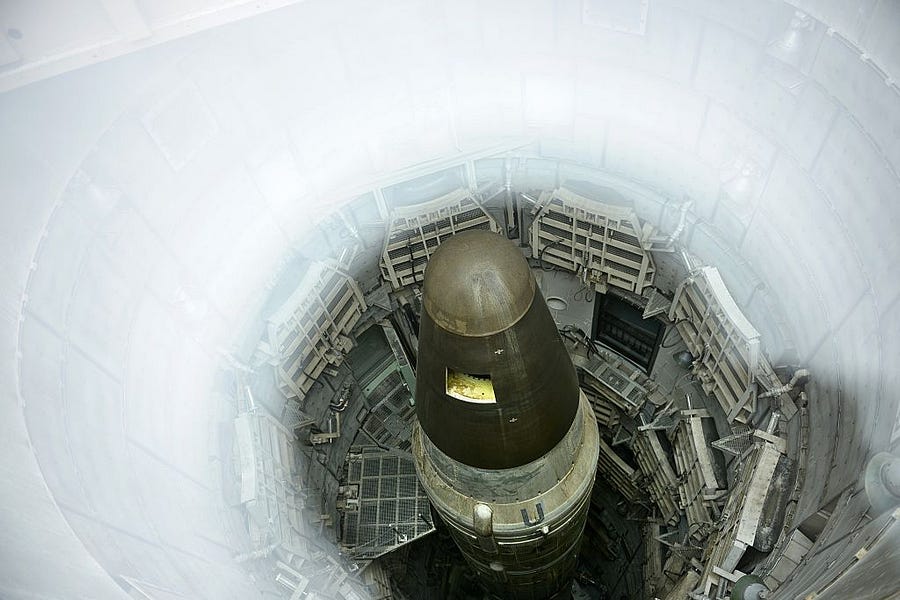The Biden administration has begun a series of reviews of the U.S. national security posture, including its nuclear posture. This will soon lead to a more formal nuclear posture review (NPR) The administration would be wise to maintain the bipartisan consensus to fully modernize the U.S. nuclear deterrent, including its production infrastructure, as part of that review. Specifically, it should move forward with plans to reconstitute a plutonium pit production capability, and to do so at two sites.
Plutonium pits are the basic ingredient in most of the world’s nuclear weapons. A pit is a “spherical shell[s] of plutonium that act as the triggers for a thermonuclear explosion.” The U.S. invented them in the Manhattan Project. But, U.S. officials made the decision to end domestic production more than 30 years ago. Strong allies like the U.K and France can make them. Likewise, Russia, the People’s Republic of China, North Korea, and Pakistan can all produce plutonium pits. Only the U.S. presently can’t make them for its deployed weapons.
Meanwhile, U.S. nuclear weapons are almost all beyond their design life. To address this problem the Energy Department has been conducting lifetime extension programs, but these refurbishments aren’t a long-term solution.
Despite the efforts of nuclear idealists who advocate abandoning the U.S. plutonium production capability, and other U.S. efforts to invest in refurbished and improved elements to our nuclear deterrent, there was significant consensus between the Obama and Trump administrations on the need to make significant improvements. This came as a great disappointment to the coterie of disarmament ideologues who had hoped Obama would make drastic cuts to or otherwise further weaken the U.S. nuclear deterrent. After all, Obama did receive the Nobel Peace Prize in his first year in office for his pledge to seek a world without nuclear weapons.
But he ultimately committed to a “safe, secure, and effective” nuclear arsenal, and like many leaders assuming the weight of responsibility, Obama wisely eschewed his more radical disarmament ideologies in favor of embracing the nuclear triad (having missiles capable of launching from land, sea, and air) and making investments in the aging U.S. nuclear deterrent. Still, by the time Obama left office, there was much left to do. The Trump administration built on what Obama had initially supported, and made a few adaptations based on the dynamic threat environment in the era of multiparty great power competition.
The U.S. holds the distinction as the only nation that extends a nuclear umbrella over 30 allies, and, yet it is also the only nuclear weapons state that does not currently possess a pit production capability.
Think of it this way, instead of buying a new car with all the modern features, we are tuning up our old car that our parents bought right off the assembly line. Never mind a new car with remote braking and airbags all around you, you’re just replacing the tires on a car that may or may not have seat belts.
The underlying weapons, even after life extension programs, are decades old and based on a design for a different era. That means uncertainty about their performance. The U.S. under the direction of President George H.W. Bush unilaterally halted testing in 1992, and each subsequent president has made the decision to maintain the moratorium. Notably, Russia and China have not been inspired to follow our example and appear to be continuing to conduct nuclear weapons testing. But with the uncertainty about the current weapons and the increased risk of failure, we may be forced to resume testing to ensure our nuclear weapons will work as intended.
Fewer issues in the annual cycle of nuclear weapons policy and budget fights have been studied more than the pit requirement. Being able to produce at least 80 plutonium pits per year is the minimum requirement articulated by our nation’s senior military and civilian leaders across administrations that bipartisan majorities of Congress enshrined into law.
For example, in congressional testimony earlier this year, the commander of U.S. Strategic Command, Adm. Chas Richard informed Congress about the risks of not rebuilding the nation’s capability to rebuild its plutonium pits: “We don’t have data that says they will work. We don’t have data that says they won’t work. But if we don’t reach 80 pits per year, we’re going to, kind of, find out the hard way how that works out.”
It is encouraging that the Biden administration’s new energy secretary, Jennifer Granholm, recently registered her support in testimony to the House of Representatives of the prior administration’s plan to reconstitute a pit production capability of no fewer than 80 pits per year at two of the National Nuclear Security Administration’s infrastructure sites: Los Alamos National Laboratory in New Mexico and the Savannah Rivers Site in South Carolina.
Maintaining two sites improves the resiliency, flexibility, and redundancy of our Nuclear Security Enterprise by not relying on a single production site. This was the conclusion after numerous studies and supported by Ellen Lord, the under secretary of defense for acquisition and sustainment, and Lisa Gordon-Hagerty, the Department of Energy undersecretary for nuclear security, both of whom were members of the Nuclear Weapons Council (NWC).
As the Biden administration undertakes its nuclear posture review, there will be the usual pressure from unilateral disarmament activists, and their few–but eager–allies in Congress, to abandon the bipartisan Obama-Trump plutonium plan. The anti-nuclear idealists will continue to push to abandon, delay, or, if all else fails, call for yet another study. The Biden administration should not fall for this delay tactic. It should instead pursue the reasonable course, based on the reality that the most dangerous kinds of threats facing the country are increasing, and the time is now to clearly demonstrate that the United States, despite our partisan divides, is united in our resolve to deter the most serious threats to our vital interests, and in doing so maintain a credible nuclear deterrent that meets the needs of the 21stcentury.
Tim Morrison was a deputy assistant to the president for national security and the senior White House arms control official and is a senior fellow at the Hudson Institute. Rebeccah L. Heinrichs is a senior fellow at the Hudson Institute.






Please note that we at The Dispatch hold ourselves, our work, and our commenters to a higher standard than other places on the internet. We welcome comments that foster genuine debate or discussion—including comments critical of us or our work—but responses that include ad hominem attacks on fellow Dispatch members or are intended to stoke fear and anger may be moderated.
With your membership, you only have the ability to comment on The Morning Dispatch articles. Consider upgrading to join the conversation everywhere.